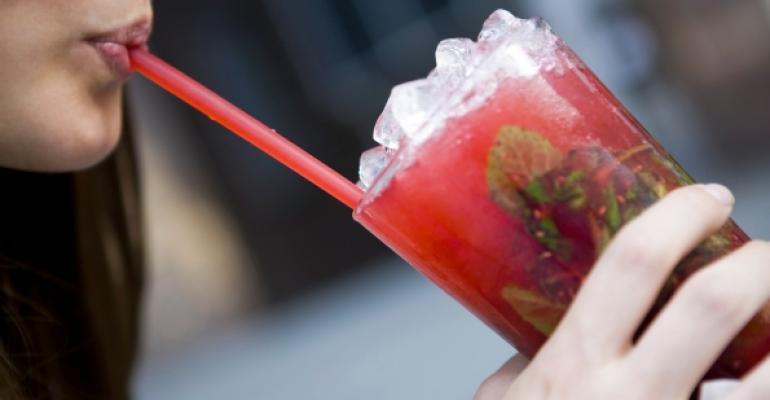Since restaurant customers drink cold beverages year round, using the right ice in every drink is important. But with summer upon us it’s even more crucial for serving and keeping every beverage the right temperature when sipped outdoors in hot weather.
The challenge for operators is to accept that no single type of ice fits every application, and since having more than one type of ice maker in house is usually cost prohibitive, achieving a balance with the best ice possible becomes the goal.
The strategy for choosing the right ice maker starts not with the machine but with the beverage menu. A quick-service operation’s needs are significantly different from a fine-dining restaurant or a craft cocktail bar, meaning all require unique machinery. Fountain drinks sold at a drive-thru window must be icy cold when customers receive them, not to mention easily sipped through a straw. Smaller, softer ice cubes or pellets work best here. But when bar patrons want a pricey spirit served chilled yet not diluted, much larger cubes — even hand-cut spheres and squares — are best for the task.
“Ice is such a crucial ingredient in a great drink, yet I think it gets overlooked way more than people think,” says Ori Geshury, director of education at the Aqua Vitae Institute in Philadelphia. The self-dubbed “ice nerd” advises operators to take their time choosing the right machine. “It’s an investment in the performance of a machine that works all day, and it’s an investment in your beverages.”
Assessing an ice machine purchase requires multiple questions, experts say:
- What is the goal of my beverage program? Rapid throughput in quick service and craft bartending would represent the extremes, and in the middle are most restaurants with modest or no bar programs and narrower drink menus. Assess both the speed (of service) and the need (for chilling and dilution).
- Are most of the beverages served sweet? If so, then dilution is important to tame those sugary notes without blunting the flavor. A coffee frappé, for example, benefits from chilly temperatures and a bit of dilution; the same at soda-heavy operations.
- Is it serving pricy spirits on the rocks or in cocktails? Chilling is important here, too, but reducing dilution is important in order to let good spirits shine through in a drink.
- Does the operation require crushing ice for smoothies or frozen drinks? If so, then smaller cubes that grind smoothly and quickly are desired.
“Look at McDonald's, which has spent thousands of hours trying to formulate an ideal ice size for their soft drinks,” Geshury says. “They need something that doesn't dilute their drinks too fast, but also cools it fast. It’s a science for sure.”
Choosing the right machine requires a bit of knowledge of industry nomenclature. Hoshizaki, for example describes four types of beverage ice its machines produce this way:
- Crescent cubes — which provide high surface area for rapid chilling and low dilution; ideal for sipped beverages like tea, fruit juices and iced coffees.
- Square cube — which provide high mass and chills effectively while diluting slowly; good for spirits served on the rocks and shaken cocktails as well as frozen drinks and smoothies.
- Cubelet a.k.a. “pellet ice” — which provides rapid chilling and fairly quick dilution; ideal for fountain drinks that will be drunk quickly through a straw.
- Top hat cube — which provides high surface area and rapid chilling with low dilution; ideal for long sipped alcoholic beverages and punches.
According to Tad Carducci, a beverage consultant with The Tippling Bros and author of the book, “A Lime and A Shaker,” machine-made crushed or flaked ice dilutes too easily for beverage use.
“Culinary crushed ice is not suitable for cocktails; save that for your seafood,” he says. “Pebble ice, which some call pellet ice, is far better. It’s become de rigueur for tiki drinks.”
On the craft end, Carducci says, are large diameter, hand-cut ice spheres and molded large squares that provide drinks gradual chilling, minimal dilution and elegant presentation. To produce hand-cut pieces requires skilled labor and access to crystal clear ice, which is commonly purchased from specialized vendors.
“When you go to that level, you’re creating an experience as much as you are a great drink,” Carducci says. “It’s an expensive proposition, but there are plenty of people who will pay for that.”
Geshury advises operators to research and test their beverage menus thoroughly before shopping for ice machines. That way operators know their desired outcome and can better “think and taste through” experiments using a wide range of ice.
“Chefs don’t just buy any old oven or grill or refrigerator,” says Larry Rice, operating partner for El Camino in Louisville. The Louisville, Ky., tequila- and rum-heavy craft cocktail bar and taqueria has seven types of ice on hand for cocktails and shared tiki punches. “Machine reliability is huge, too,” he says. “Even the best drink program is worthless if your ice machine is down on a Saturday night.”




